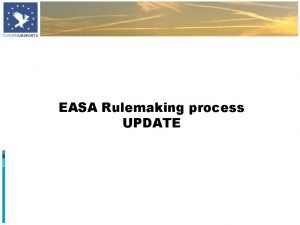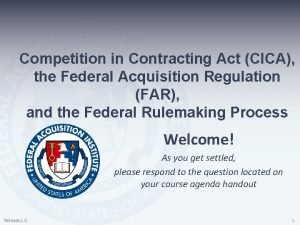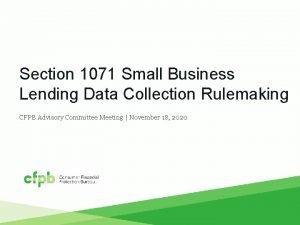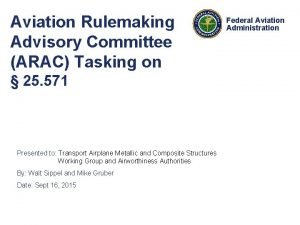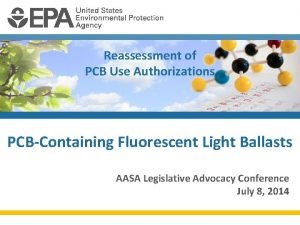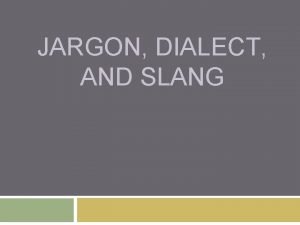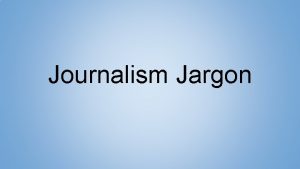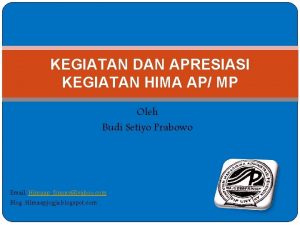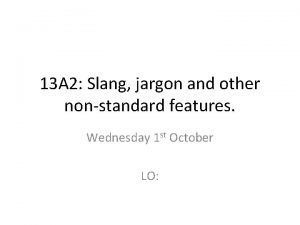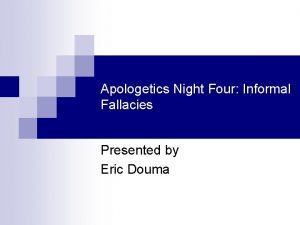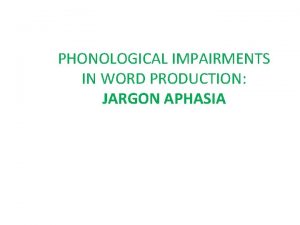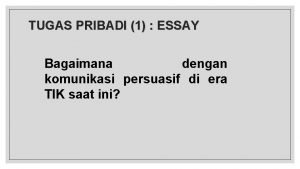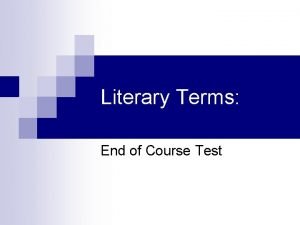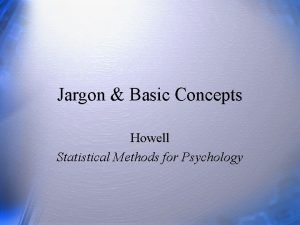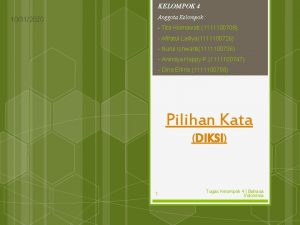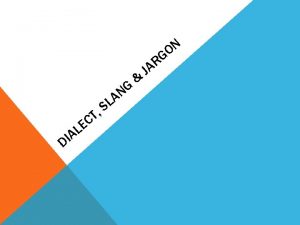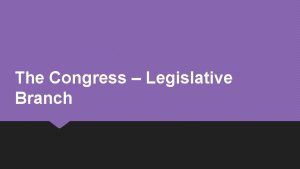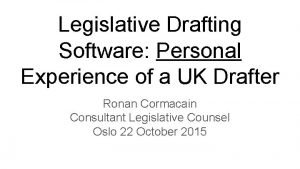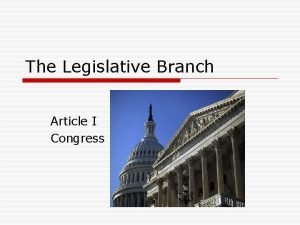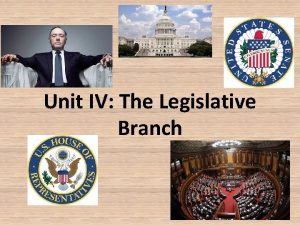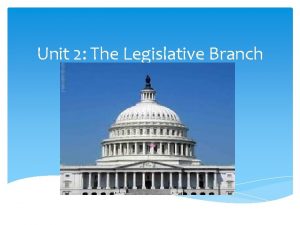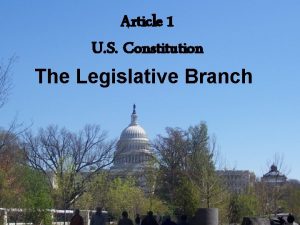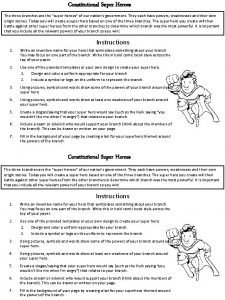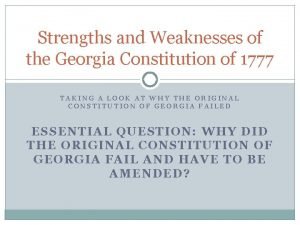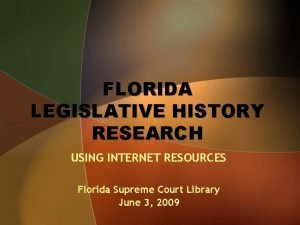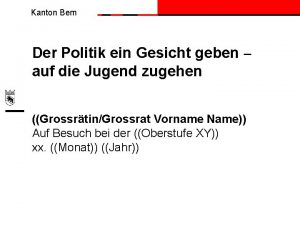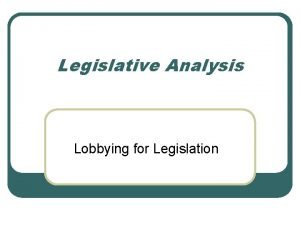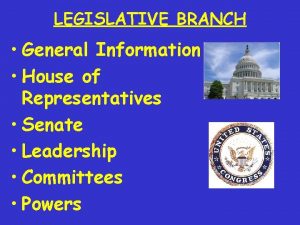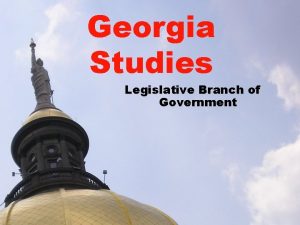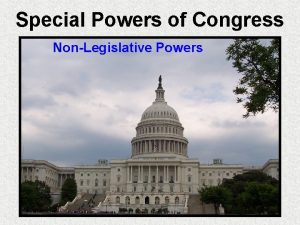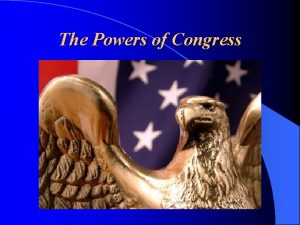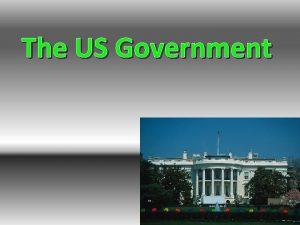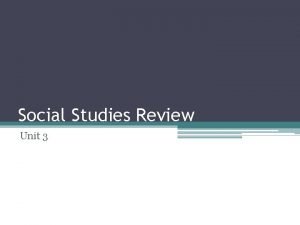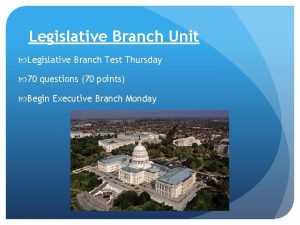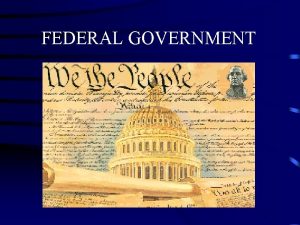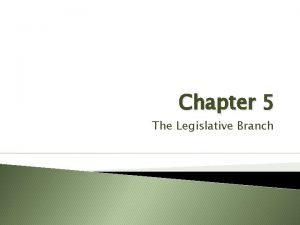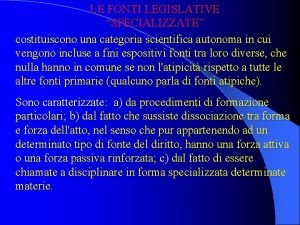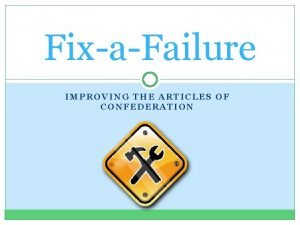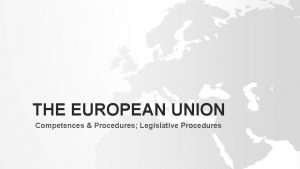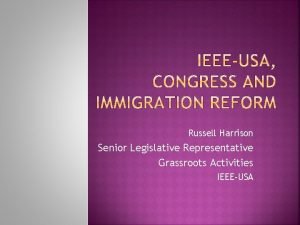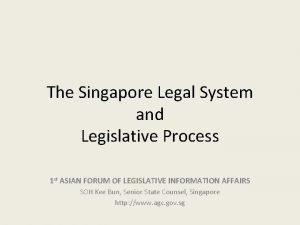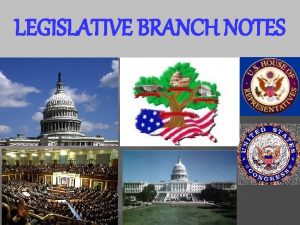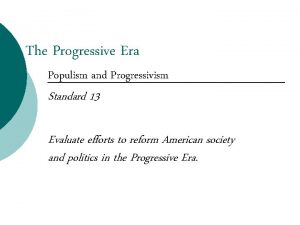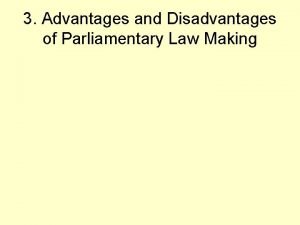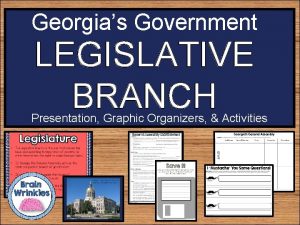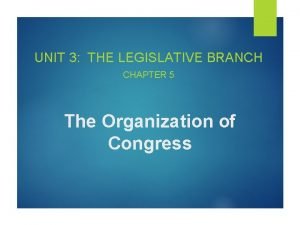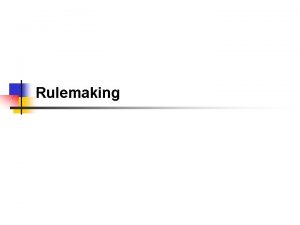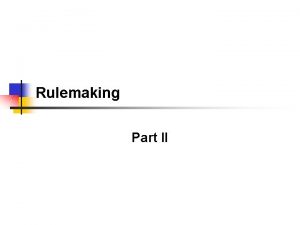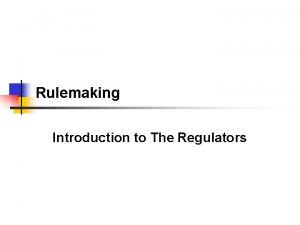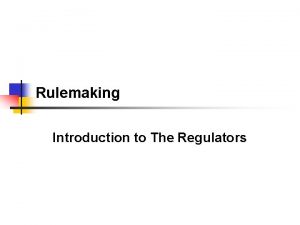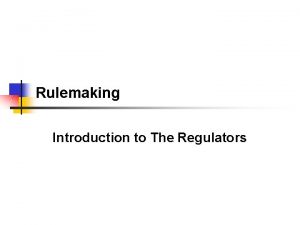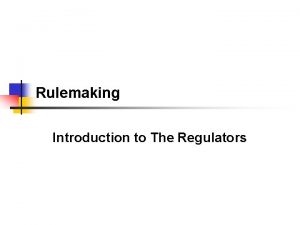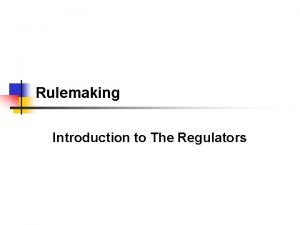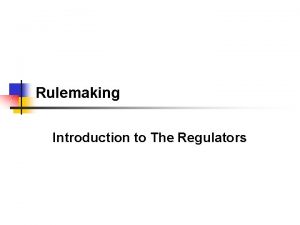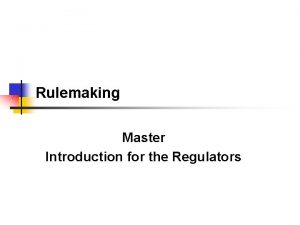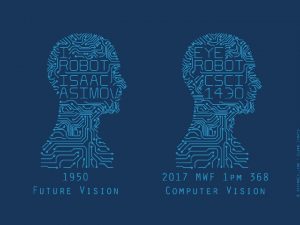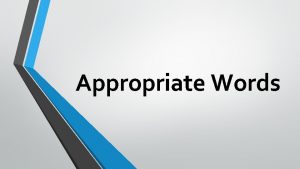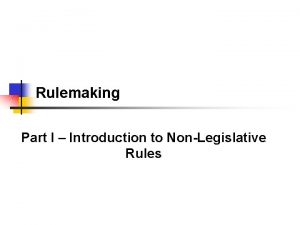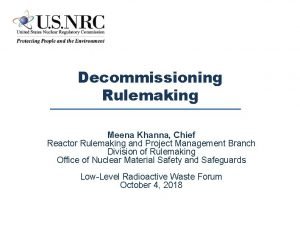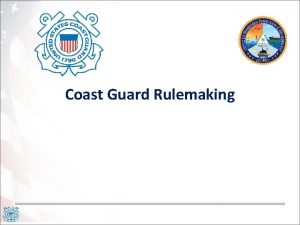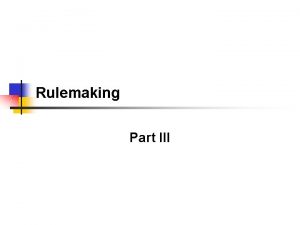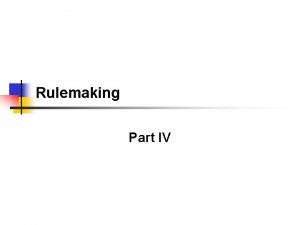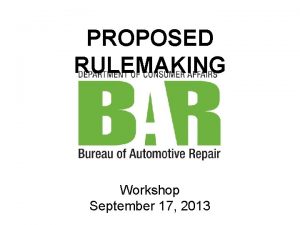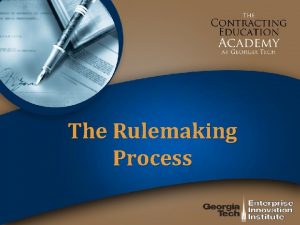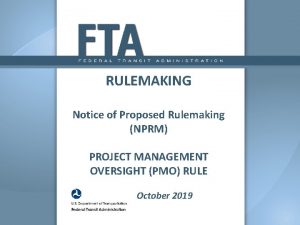Rulemaking Jargon Alert n n Rule legislative rule































![553(b) – [General] Exceptions to Notice Requirements n n n 1) Interpretative rules, general 553(b) – [General] Exceptions to Notice Requirements n n n 1) Interpretative rules, general](https://slidetodoc.com/presentation_image/c8e450bfec5afc4b86402eff0729fb9b/image-32.jpg)
































- Slides: 64

Rulemaking

Jargon Alert n n Rule, legislative rule, or regulation n They all mean the same thing n Has the same effect as a statute passed by the legislature Non-Legislative rule n Has no legal effect, but shows what the agency thinks the law is n Many names - interpretive rule, guidelines, guidance document, anything but rule or regulation 2

The Agency as Legislature n n The modern rulemaking process got started in the 1950 s and really accelerated in the 1970 s n Parallels the growth of federal agencies In theory, the federal courts encourage agency rulemaking. n It reduces litigation and simplifies the litigation that ensues. 3

The Power to Make Rules n n The power to make rules must be delegated by the legislature. n If the enabling legislation (the legislation creating an agency) is silent, the agency cannot make rules The delegation may be broad, allowing the agency great discretion, or very narrow. n We will look at the standards for reviewing this delegation later in the 4

Must the Agency Make Rules? n n n If the agency has the power to make rules, it has the discretion on what rules to make and when to make them. The legislature can put provisions in the agency legislation requiring that certain rules be made, and the timeframe for making them. n The Clean Air Act required rulemaking to flesh out detailed technical standards Unless there is a legislative directive, it is difficult to get the courts to force an agency to make rules 5

Why Make Rules? n n Many statutes have too little detail to be enforced without additional rules. Rules can be used to tailor a statute to new circumstances. Rules provide a chance for the public to participate in the regulatory process Once promulgated, a rule in binding on every party, reducing the need for 6

Uniformity Rules set up a general framework that treats all parties uniformly n Rules are the fairest way to make big regulatory changes n If the agency does not have rules, it can change enforcement policy from case to case, and is also at the mercy of judges to accept or reject agency standards n 7

Adoption of National Standards n n National standards can be adopted through agency rules, harmonizing practice across jurisdictions n National building codes n CDC guidelines on food sanitation n Recommendations of the Advisory Committee on Immunization Practices LA and building codes 8

Agency Efficiency n n While a rulemaking can be expensive and time consuming, it can settle issues which might otherwise have to be litigated in every enforcement case Rulemaking can also eliminate many hearings by resolving factual questions n In disability cases, rules can be used to establish what constitutes a disability, rather than making it as case by case determination. 9

Agency Oversight n n n You can control the outcome of rulemaking much easier than that of adjudications n Not dependent on ALJs (administrative law judges) n This especially important in LA More input from across the agency n Input from the public as well Directly controlled by agency policy 10

How Does the Nature of the Enabling Act Affect Rulemaking? n n Very general laws n Limited detail in the statute n Any interpretative rule is likely to been seen as a legislative rule because it will provide more limits than the statute. Very specific laws - like the ADA n No room for legislative rules n Everything is guidance 11

The Politics of Rulemaking n n Congress often dodges the hardest issues and leaves them to agency rulemaking Most of these involve cost-benefit analysis n How do you trade off automobile safety with price and fuel efficiency? n Are you more worried about delaying the entry of new drugs or the about allowing the sale of a drug with dangerous side-effects? n Do you want cheap power at the cost of lots of asthma and the Grand Canyon full of smoke? 12

Downside of Rulemaking n n n Trials (adjudications) involving single parties can be more flexible in the individual cases Adjudications are useful when you are not sure what the rule should be and need more info and a chance to experiment Rules can be so abstract or overbroad that they are expensive or difficult to follow n Like statutes 13

Rulemaking Ossification n n The courts and legislatures have increased the burden on rulemaking, especially in states n Rulemaking has gotten so complex and time consuming it has lost some of its value n Complicated by regulatory conflict and incompetent agency practice Rulemaking can go on for years n What is the legal value of a proposed rule that has not been finalized? n The Medicare anti-kickback regulations were delayed for years 14

Definition of a Rule n n n APA 551(4) n (4) 'rule' means the whole or a part of an agency statement of general or particular applicability and future effect designed to implement, interpret, or prescribe law or policy or describing the organization, procedure, or practice requirements of an agency and includes the approval or prescription for the future of rates, wages, corporate or financial structures or reorganizations thereof, prices, facilities, appliances, services or allowances therefor or of valuations, costs, or accounting, or practices bearing on any of the foregoing; Not a clear definition 15 Things that are not adjudications or licensing

LA Definition n n 6) "Rule" means each agency statement, guide, or requirement for conduct or action, exclusive of those regulating only the internal management of the agency and those purporting to adopt, increase, or decrease any fees imposed on the affairs, actions, or persons regulated by the agency, which has general applicability and the effect of implementing or interpreting substantive law or policy, or which prescribes the procedure or practice requirements of the agency. "Rule" includes, but is not limited to, any provision for fines, prices or penalties, the attainment or loss of preferential status, and the criteria or qualifications for licensure or certification by an agency. A rule may be of general applicability even though it may not apply to the entire state, provided its form is general and it is capable of being applied to every member of an identifiable class. The 16

Functional Definitions n n n General applicability, as opposed to specific parties Prospective Binding on the agency as well as on the public 17

Notice-and-Comment Rulemaking n n n APA Procedures http: //biotech. law. lsu. edu/Courses/study _aids/adlaw/553. htm The Register n The Federal Register n LA Register Electronic Notice http: //www. regulations. gov

Why Have Public Participation? n n n Public participation has great political benefit in broadening the acceptability of the rules. Public comments can identify technical and legal problems with the rules Publication of proposed rules allows politicians to become involved to protect the interests of their constituents Public participation limits executive power and makes it more palatable to the courts to have agencies making laws While the agency may take comments at public hearings, it is usually done in writing. 19

Attacking Rulemaking n n Once a rule has been properly promulgated through notice and comment, it can only be attacked by attacking the published basis for the rule, and that must be done relatively soon after promulgation. We will see in the movie how the opponents of the rule work to get their changes made before the rule is finished. 20

Rule or Adjudication?

Londoner v. City and County of Denver, 210 U. S. 373 (1908) n n The City of Denver paved the road in front of plaintiff’s property. Under the law at that time, property owners were liable for the cost of such improvements. Plaintiff’s individual assessment was based on specific factors about this property. The court found that plaintiff was entitled to present evidence and be heard on his objections to facts on which his assessment was based. 22 This hearing is an adjudication.

Bi-Metallic Investment Co. v. Colorado, 239 U. S. 441 (1915) n n The State Board of Equalization determined that property was undervalued in Colorado and imposed a rule that all evaluations be increased by 40%. n This was not a reevaluation of each piece of property, but a uniform and mechanical increase in the individually determined valuations. The court found that there is no right to a 23 hearing for rules of general applicability.

Orders versus Rules n n Rules are directed to the universe of regulated parties, not to individuals. Agency directives to specific parties based on individual facts are called orders. They may trigger a hearing for the individual, but do not need notice and comment. Assume the EPA makes a rule that applies to copper smelters which are located more than 5, 000 above sea level. n What is there is only one? n Is this still a rule? Do we see statutes directed at single parties? 24

APA Rules Must have “Future Effect” n n In Bowen v. Georgetown University Hospital, 488 U. S. 204 (1988), HHS changed the reimbursement rules for care that had already been rendered. n Why is that problem for a rule? n Can Congress fix this or is it a constitutional issue? Can there be retroactive laws? n Superfund? 25

The Effect of a Rule in an Adjudication n The FCC is concerned that concentrated ownership of TV stations is not in the public interest. Licensing is an adjudication, i. e. , the applicant is entitled to a hearing if his license is turned down. The FCC issues a rule that no one can own more than five stations. n Does an applicant with 5 stations get a hearing when he is turned down based on the rule? n Why or why not? n United States v. Storer Broadcasting Co. , 351 U. S. 192 (1956) 26

Do You Have to Have Notice and Comment?

Why Avoid Notice and Comment? n n Notice and comment is time consuming and subject to long judicial delay. n What is the risk to the agency if it issues guidance without notice and comment, and the court finds the guidance to be a rule requiring notice and comment? What is the benefit to the regulated parties of interpretive rules and guidance? n What if the agency is prevented from providing guidance documents? 28

Exemptions to Notice and Comment Requirements (does 553 apply at all? ) n § 553. Rule making n (a) This section applies, according to the provisions thereof, except to the extent that there is involved n n (1) a military or foreign affairs function of the United States; or (2) a matter relating to agency management or personnel or to public property, loans, grants, benefits, or contracts. 29

Military and Foreign Affairs n n n Limiting the term of residence for Iranian nationals after the hostage incident Extending asylum to persons subject to reproductive restrictions in China Deporting young Muslin men with visa problems. Changing international trade rules Why exempt these? 30

Public Property n n n (2) a matter relating to agency management or personnel or to public property, loans, grants, benefits, or contracts. n This would exempt Social Security benefits, everything to do with public lands, and many other areas of regulation. As the regulatory state developed, there was pressure to repeal this provision. n To defuse this, agencies adopted rules requiring notice and comment rulemaking in several of these areas. n Congress has suspended this section in many enabling laws. You have to look at the agency’s own rules and 31
![553b General Exceptions to Notice Requirements n n n 1 Interpretative rules general 553(b) – [General] Exceptions to Notice Requirements n n n 1) Interpretative rules, general](https://slidetodoc.com/presentation_image/c8e450bfec5afc4b86402eff0729fb9b/image-32.jpg)
553(b) – [General] Exceptions to Notice Requirements n n n 1) Interpretative rules, general statements of policy, and rules of agency organization, procedure, and practice; and 2) Rules when the agency finds for good cause that notice and public procedure are impracticable, unnecessary, or contrary to the public interest. No notice means no comment under 32

Legislative and Nonlegislative Rules n n Agencies can only make legislative rules if the legislature delegates this power to the agency through statute. Nonlegislative rules (guidelines, etc. ) do not have legal effect. They only explain the agency’s view of the law. n Does an agency need statutory authorization to issue non-legislative rules? 33

Can Nonlegislative Rules be Retroactive? n n Why does the ban on retroactive rules not apply to interpretive rules? n How do judges change the law retroactively? If interpretive rules cannot change legal rights, does retroactive really mean anything for nonlegislative rules? 34

Exception 1 - Interpretative Rules n n It is only explaining the law or providing guidance for action n Prosecution guidelines n IRS audit guidelines Since they do not change the law, they have no legal effect n Like commentary in the civil law? n Does that mean you can ignore them? 35

EPA Example – Is This Definition a Rule? n n EPA says that the term “waters of the United States” (which defines the jurisdiction of EPA under the Clean Water Act) includes wetlands that potentially provide habitat to migratory birds. n This might include a pothole in a field, not otherwise connected to a waterway. If the EPA has jurisdiction over the wetland, it will become expensive or 36

Is this an Interpretative Rule or a Legislative Rule? n n Can we tell by just looking at the rule? How might this definition affect the value of the wetlands? n Is this a “substantial impact”? Assuming that it is a substantial impact, how can the agency defend not using notice and comment? The substantial impact test has now been mostly abandoned in favor of the “legally 37 binding” test.

The “Legally Binding” or “Force of Law” Test n n n Can the agency enforce the law without the rule? Continuing with the previous wetlands example n Is the agency required to define wetlands before enforcing the statute? n Was the agency doing enforcement before this rule? n If so, does this change the enforcement? n What does tell us about whether it is legally binding? Assume a statute allows the agency to define toxic substances that cannot be dumped into lakes. n Would a list of these substances need notice and comment? 38

How High do I Build the Fence? Hoctor v. USDA, 82 F. 3 d 165 (7 th Cir. 1996) n n Statute requires the agency to adopt rules for the safe housing of dangerous animals n Agency uses notice and comment to promulgate a rule requiring that reasonable precautions be taken to prevent the escape of the animals n Agency then issues guidance saying that a reasonable precaution would be an 8 foot fence. Interpretation or legislation? n How does it change the proof of facts in the 39

Junk in the Park: United States v. Picciotto, 875 F. 2 d 345 (D. C. Cir. 1989) n n Can the agency use notice and comment to promulgate a legislative rule that says that the agency can add other requirements in specific situations without notice and comment? n Why or why not? What if the rule just says that nothing can be brought to the park that would be disruptive or impede public access? n Would it need a specific list? n How does not having a rule affect 40 enforcement?

‘‘Encoding a Substantive Value Judgment’’ Test. n n The D. C. Circuit uses what it described as asking whether an agency’s rule ‘‘encodes a substantive value judgment or puts a stamp of approval or disapproval on a given type of behavior. ’’ n Is this really a different standard than substantial effect? n Does this look like the standard for guidelines, such as in the Hoctor case? Limited to the DC Cir. and does not seem to 41 make much difference.

General Policy Statements and Procedural Rules

Agency Procedures n n Like the code of civil procedure n Does not change the substantive rights of the parties n Does not change the regulated behavior, only the process in agency procedures Thus no need for public participation. 43

General Policy or Specific Requirements? n n Remember, 553(b) does not require notice and comment for general policy statements or procedural rules. Assume the statute says that in licensing actions, a physician must reply to agency request for information in a reasonable time. n How would you argue that a 7 day answer period is a substantive change, not just a procedural requirement? n Why does the inclusion of specific factual information (deadline periods, fence heights)44

Federal Mine Safety and Health Act Example n n Secretary has the statutory right to sue both the mine owner and the mine operator for violations of the Act. Secretary publishes a policy statement explaining that the agency can and will sue both of them for infractions, depending on the nature of the infraction. n Does this require notice and comment? 45 n Why?

Enforcement Manual n n The Coast Guard is authorized to investigate and enforce against certain types of oil pollution in the waters of the United States under the Clean Water Act. n To aid its officers engaged in these functions it has created a Marine Safety Manual. n That Manual gives guidance as to what appropriate penalties might be for various types of pollution incidents. n The range of penalties is specified in statutes. Legislative rule or prosecution policy? n What is the key? 46

Corps of Engineers Example n n n Corps issues a guidance document providing examples of ways to mitigate wetlands damage. n One way is to promise to restore 2 X as much wet land as you fill. Does this need notice and comment? n Why or why not? What if the Corps will only issue permits to people who agree to this? n How would you prove this? 47

Setting a Threshold for Prosecution n n The FDA issues a policy statement that it will not take enforcement actions against candy bars unless they have more than 5 insect parts per bar. n There is no statutory standard. You represent Consumers Disgusted by Bug Parts, Inc. n What is your argument that this is really a rule? 48 n Community Nutrition Institute v.

Coercion: Chamber of Commerce v. U. S. DOL, 174 F. 3 d 206 (D. C. Cir. 1999) n n DOL made a policy statement that it would reduce inspections of workplaces that adopted an OSHA suggested safety plan that exceeded federal minimums n Is this really voluntary? n What happens if you do not comply? n Does coercion make this a binding rule? What about DOJ guidance that a corporate compliance plan will count as mitigation under the Sentencing Guidelines? n Does it affect law abiding companies? 49

Substantial Impact Test for Procedural Rules n n The Department of Health and Human Services changed the method by which home health providers could obtain reimbursement for expenses under the Medicare Program. In particular it required that they submit their requests in a new format and to regional intermediaries, rather than to HHS directly. How did plaintiffs argue that this was a 50 legislative rule, rather than a procedural

Inspection or Prosecution Guidelines n n n OSHA adopts a plan for deciding which employers to inspect. A selected employer contests the rule, saying that OSHA inspections are expensive and time consuming, thus this has a substantial impact. Is this a successful argument? n Why, or why not? 51 n How is this different from the coercion

Stopped here 52

Substantial Impact Test for Procedural Rules and Policy Statements – Wrap-up n n n Same analysis as substantial impact or legally binding test for substantive rules. What is the actual impact on your client? n Will compliance costs significantly increase – Medicare case? n Does it change their legal options – shortened period to reply to complaint? n Does it actually change substantive requirements – requiring new information for a benefit determination? We will revisit this when we look at standing. 53

Consistency, the Hobgoblin of Interpretative Rules n n What is the result if an interpretative rule is inconsistent with a legislative rule? n Using an interpretative rule to change a calculation established by a rule Some courts have found that an interpretative rule cannot be changed with a subsequent interpretative rule, but can only be modified by a legislative rule n Why is logically inconsistent? 54 n This is not widespread.

Does Publication Matter in Deciding if a Rule is a Legislative Rule? n n n The Register n The Federal Register n LA Register Electronic Notice http: //www. regulations. gov Documents that have ‘‘general applicability and legal effect’’ must be published in the FR. n Must interpretative rules be published in the FR? n What does failure to publish indicate? n Does this make sense? Is it important that the agency clearly label the rule as interpretative? 55

Interpretive Rule or Legislative Rule Wrap Up n n Does it force regulated parties to change their actions? Does the agency treat it as binding? n Does it allow exceptions? Is it necessary to enforce the statute? n List of pollutants, for example. Does it provide specific details which limit the action of regulated parties? 56

Notice and Public Procedures Are Impracticable, Unnecessary, or Contrary to the Public Interest

Actions where Secrecy is Important n n n Wage and price controls Bidding on contracts Negotiations on land purchases and sales 58

Emergencies and Impracticality n n Emergency Rules n http: //www. doa. la. gov/Pages/osr/emr/e mr. aspx n Misused in LA n This GAO Report indicates that the feds may also misuse this exception. Interim Final Rules n Published and in effect, but will be 59

Time Constraints n n n The GAO found that agencies frequently skip notice and comment when they have to make a rule with a short timeframe. n Usually statutory deadlines, or a version of emergencies. n Classic would be hunting seasons. How would this have helped in the Regulators? n How did notice and comment improve the rule? Should the agency be able to use this 60

Technical Corrections n n n Calculations and other non-discretionary rules Technical corrections n Can require notice and comment if the correction causes a different result. Theory is that these are mechanical and thus notice and comment would not add any new information. 61

What is Formal Rulemaking? n n A rulemaking conducted as a trial type hearing n The agency support for the rule must be presented at the hearing n Interested parties may present and crossexamine evidence History - grew out of rate making in the early 20 th century. n Rate making affects a small number of parties 62 n The courts thought they should get due

Why avoid formal rulemaking? n n The peanut hearings (FDA must do formal rulemaking in some situations) n Should peanut butter have 87 or 90% peanuts? n 10 years and 7, 736 pages of transcript What was the concern in Shell Oil v. FPC? n Formal rulemaking was impossibly time consuming to use for regulating something changeable such as natural 63 gas rates.

When is Formal Rulemaking Required? n n n Disfavored by the modern courts Must have magic statutory language or be required by the agency's on rules n Only when rules are required by statute to be "made on the record after opportunity for an agency hearing" Lawyering tip n When would you want to argue that formal rulemaking is required? 64 n What do you have to do to support your
 Non legislative powers
Non legislative powers Easa rulemaking process
Easa rulemaking process Cica far
Cica far 1071 rulemaking
1071 rulemaking Aviation rulemaking advisory committee
Aviation rulemaking advisory committee Rulemaking process steps
Rulemaking process steps Dialect in a sentence
Dialect in a sentence Jargon
Jargon Journalist jargon
Journalist jargon Jargon hima
Jargon hima Lexique rugby humour
Lexique rugby humour Jargon in linguistics
Jargon in linguistics Example jargon
Example jargon Reductive fallacy examples
Reductive fallacy examples Phonemic jargon
Phonemic jargon Bagaimana dengan komunikasi persuasif di era tik saat ini
Bagaimana dengan komunikasi persuasif di era tik saat ini Creoles definition
Creoles definition Aorta
Aorta Imagery examples
Imagery examples Statistical jargon
Statistical jargon Jargon kelompok 4
Jargon kelompok 4 Pidgin language
Pidgin language What is jargon and give examples
What is jargon and give examples Legislative automated workflow system
Legislative automated workflow system Interesting facts about legislative branch
Interesting facts about legislative branch Non legislative powers of congress
Non legislative powers of congress Legal drafting software
Legal drafting software Congress legislative branch
Congress legislative branch Whats the purpose of the legislative branch
Whats the purpose of the legislative branch Congress per state
Congress per state Article 1 the legislative branch
Article 1 the legislative branch Constitutional hero
Constitutional hero Georgia constitution of 1777 strengths and weaknesses
Georgia constitution of 1777 strengths and weaknesses Florida legislative history
Florida legislative history Legislative kanton bern
Legislative kanton bern Legislative analysis
Legislative analysis How to draw legislative branch
How to draw legislative branch Information about the legislative branch
Information about the legislative branch Legislative branch of georgia
Legislative branch of georgia What are the non legislative powers of congress
What are the non legislative powers of congress Non legislative duties of congress
Non legislative duties of congress Legislative branch meaning
Legislative branch meaning Congress building
Congress building Legislative branch
Legislative branch Judicial legislative and
Judicial legislative and Non legislative powers of congress
Non legislative powers of congress Legislative branch unit test
Legislative branch unit test Legislative branch powers
Legislative branch powers Georgia state government
Georgia state government Chapter 5: the legislative branch answer key
Chapter 5: the legislative branch answer key Fonti legislative specializzate
Fonti legislative specializzate What are some failures of the articles of confederation?
What are some failures of the articles of confederation? Art 289 tfeu
Art 289 tfeu Senior legislative representative
Senior legislative representative Senate branch
Senate branch Legislative
Legislative Law making process in singapore
Law making process in singapore Legislative, executive, and judicial,
Legislative, executive, and judicial, Legislative branch notes
Legislative branch notes Populism and progressivism
Populism and progressivism What is the political system
What is the political system Parliamentary law making advantages and disadvantages
Parliamentary law making advantages and disadvantages Legislative branch song
Legislative branch song Unit 3 legislative branch test
Unit 3 legislative branch test Implied power example
Implied power example

